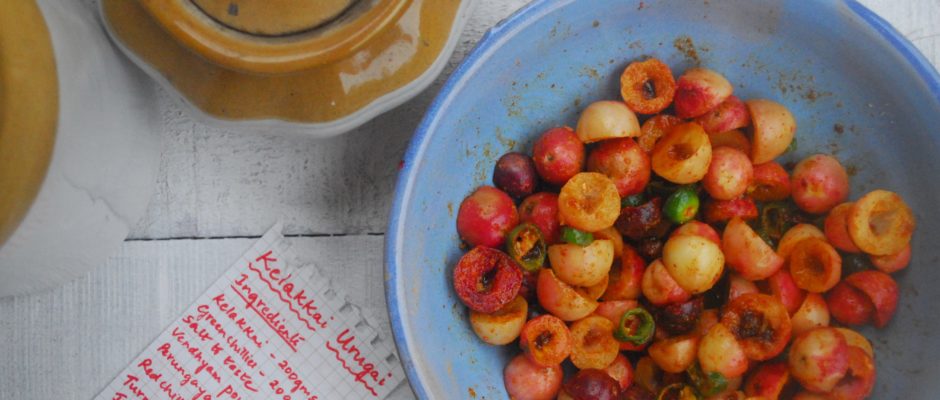Simplicity Coimbatore ,Kalakkai pickle
For the past few years close family relatives of ours have been sharing with us some of their kalakkai harvest.
Since first setting eyes on this pretty pink and white berry,I have looked for more information on the kalakkai ,by way of recipes,nature of the plant etc.. That’s when I noticed a healthy ,young kalakkai tree at my aunt’s house. The plant itself is attractive with it’s bushy appearance and lush foliage.The white flowers and the pink fruit add to it’s beauty.
Apparently there are two varieties of kalakkai.It’s referred to as chinna (small) kalakkai and periya (big) kalakkai owing to the difference in size but I have yet to come across the chinna kalakkai plant. I have tasted the kalakkai pickles made at Mahalakshmi foods by Gokula amma. The taste is that of a traditional South Indian pickle and it’s delicious.
This year also we received our annual kalakkai gift. I was determined to do something with it straight away. Almost as if instagram was a mind reader,the first picture to pop into my feed was cut pieces of kalakkai and green chillies. The photo was posted by the masala monk brand who are well known for their delicious home made pickles. The picture was accompanied by a caption which said karonda and green chilly pickle.Since the colours and shape of the karonda looked exactly like the kalakkai that was right in front of me on the table,I looked up the name to double check if it was the same ingredient and indeed it was !
The botanical name is ‘Carissa carandas’ and it’s also referred to as Bengal currant , carandus plum and karanda .While it is cultivated in many parts of India, this shrub is indigenous to the Western ghats as well as the Sivalik hills of the Himalayas. In other words it grows naturally here and thrives extremely well even in drought. The flowering and fruiting season is between July and September.It’s also best to plant this during the first monsoons. Apparently it can take root when planted as a seed or as a cutting.

The pictures on the masala monk page kept getting infinitely tempting and despite having no recipe in hand I decided to give it a go. While looking through the masala monk website ,it was a pleasant surprise to see that they had listed the ingredients necessary for making this pickle.Their recipe was a combination of ingredients like the panch phoran which will complement the taste of the mustard oil used. Since we have less access to an organic mustard oil here, I decided to go with a mix of ingredients which would go with our local nallennai.
What I did love was the thought of using fresh green chillies.For starters the colours of the chillies and the kalakkai complemented each other so beautifully and looked so appetising. The best part of recipe development is having a clear idea of the flavours and then working towards it coming together.
I did come across a mention online that it was difficult to extract the seeds of the kalakkai but it was quite simple. So out came an old ,blue and ochre earthenware bowl and in went the chopped green chillies.After washing the kalakkai, we dried it thoroughly and chopped it in half,right down the middle. To remove the seeds ,all it took was to use the tip of the knife and gently scoop the small, thin ,oval bits out. As we were completely absorbed in this process,I couldn’t help but marvel at the entire gamut of pink hues that the kalakkai displayed.The very young ones were more whitein colour with a blush of pink while the fully mature ones were a of a deep burgundy. They were quite stunning. After tasting a small piece,we realised that it was sour,like a gooseberry with a crunchy texture.

After all the knife work was done,out came the spice powders. My practice with making an instant mango pickle is what came to the forefront while choosing flavours. So in went the roasted fenugreek powder (vendhayam), perungayam (asafoetida), salt ,turmeric powder and red chilli powder. Oh the aromas emanating from that bowl were simply divine!

We let it sit for a while for the kalakkai and chillies to absorb the spices and also to take some post worthy pictures, before adding the hot oil. Usually we add curry leaves, mustard seeds and dried red chillies to the mango pickle. But in order to complement the flavour of the kalakkai we added whole seeragam (cumin) to the hot sesame oil (nallennai).As soon as the oil heated up ,the pan was taken off the fire and the hot oil was carefully ladled over the marinated kalakkai and green chillies.The swoosh of the hot oil coming into contact with fresh ingredients is such a rewarding sound.

The kalakkai pickle was left to steep for 2 weeks before we tasted it. It is without a doubt one of the tastiest pickles we have ever experimented with .The chillies, the vendhayam and the perungayam complement this sour ingredient to perfection. All I want to do now is head to my aunt’s house to pick more of the kalakkai.

Note
Sri Mahalakshmi Foods: 91A,
Balaji Kovil lane. Ph: 2394597


No comments yet.